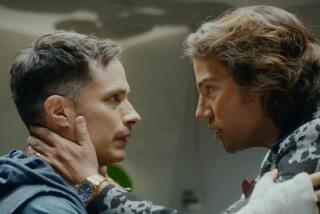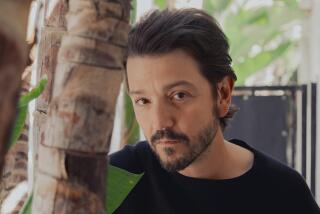Training Wheels Are Still Spinning for De La Hoya
- Share via
SAN ANTONIO — Let’s take the latest look at Oscar De La Hoya’s fabulous, fun-filled, always fascinating training wheel of fortune, 24 fights into his multimillion-dollar career:
Trainer Jesus Rivero is out, Emanuel Steward is in, and Robert Alcazar, pushed out after feuding bitterly with Rivero, is back in as De La Hoya prepares for Saturday’s fight at the Alamodome against David Kamau.
But wait: De La Hoya says Rivero might be welcomed back soon. That is, if Rivero, once considered De La Hoya’s sage, will stop chopping at De La Hoya in Mexican newspapers and get over being fired a few months ago without hearing from the superstar fighter.
“If I’m lacking defense once again, we’ll bring him back,” De La Hoya said recently. “Absolutely. The door is definitely open.”
Revolving doors, of course, never close. But what’s forcing all these changes: the nature of his high-profile, high-risk career, or a foible of an impetuous star surrounded by back-stabbers?
“Oscar’s not a fickle person,” said De La Hoya’s promoter, Bob Arum, trying to explain the constant chaos of comings and goings. “But he’s also a very highly intelligent person, and if it’s not getting done, you’ve got to get it done.”
De La Hoya is enthusiastic about Steward’s arrival as the lead trainer and the peaceful working relationship he currently shares with Alcazar, calling this his “most relaxed camp ever.”
“It’s like golf. If a teacher’s not teaching you, you’ve got to get another one, until your game is right, until your game is perfect,” De La Hoya said. “You have to better yourself.”
Rivero, hailed not long ago by the De La Hoya camp for refocusing the fighter and providing him with the defensive techniques he needed as he moved up in weight, was fingered for being too defense-oriented, at 67, too old, and too dictatorial after De La Hoya’s last two, non-knockout victories over Miguel Angel Gonzalez and Pernell Whitaker.
Reached at his hometown in Yucatan, Rivero, through a translator, accused Alcazar and De La Hoya’s father, Joel, of undermining him because they were jealous of his increasing influence over De La Hoya, and repeated how hurt he was that De La Hoya never called him after the firing.
“Yeah, it was a big mistake on my part, not personally calling him,” De La Hoya said. “But hey, I was on vacation. I didn’t know all this was going on. I mentioned to [advisor] Mike Hernandez that I wanted Emanuel Steward and everything just happened so fast.
“I didn’t have the chance to call Rivero in time, to apologize, to say ‘This is all business; we’ve got to move on.’ ”
Rivero said the trainer changes aren’t caused by a flaw in De La Hoya’s character so much as the burden of his situation. Because De La Hoya is such a cash cow for so many people--he could earn more than $30 million in boxing purses in 1997 alone--every time there is a minor stumble, Rivero says, everybody goes looking for someone to blame, and the fighter usually goes along with the crowd.
Alcazar, De La Hoya’s amateur trainer and pro trainer for his first 17 fights, got bumped in favor of Rivero after an iffy performance against John John Molina. Seven fights later, it was Rivero’s turn to get the nudge.
“If he wanted others to come in so that he could turn into a knockout artist, then I respect his opinion,” Rivero said. “But I’m almost certain that he suffered from pressures and afterward he didn’t even have the courage to call me, to come and say, ‘Senor Rivero, thank you very much for all that I’ve learned.’
“Maybe Oscar didn’t call me because he was afraid or he was embarrassed. But I’m very comfortable. Because I know the situation. Time will prove me right. And they will suffer other consequences of what will happen. Oscar will not learn. With time, Oscar will realize what the situation is.”
While pointing out that Rivero’s game plan was faulty--pressing De La Hoya to move to his right against Whitaker’s left-handed stance instead of the standard strategy of moving to the left--De La Hoya denies that he was looking for a scapegoat.
“I take all the responsibility, 100%, for the Whitaker fight,” De La Hoya said. “I was confused. But I take total responsibility.”
Interestingly, Rivero says that De La Hoya did not do what he told him to do against Whitaker, that the fighter was unwisely trying for a quick knockout and got frustrated early, flubbing the game plan of steady body shots throughout a long fight.
Arum describes the trainer-to-trainer movement as a natural progression, from amateur trainer to learned fix-it man and now, with the veteran Steward, to someone supremely qualified to polish the jewel.
Steward, known for his tutoring of Thomas Hearns and his famous Kronk Gym in Detroit, seems a bit baffled that De La Hoya would be criticized for leaving Rivero, who hadn’t trained a fighter since flyweight champion Miguel Canto in the 1970s.
“We always talk about the fighter being shot, that he’s rusty,” said Steward, who was in Gonzalez’s corner in January against De La Hoya. “It’s the same way for trainers and everyone else too.
“I think with Rivero, that wasn’t taken into consideration. That’s nothing personal against him. But his whole career had been off of one fighter, one style, a boxing style. . . . And you just cannot take a knockout fighter like Oscar and try to mold him along those lines.”
Rivero did not approve of De La Hoya’s increased dedication to weightlifting and interval running, and did not allow De La Hoya to use either the speed bag or one of his favorite drills, the punching mitts.
“Anyone else would have objected, but Oscar being the gentleman he is, he just went along with it,” Steward said.
De La Hoya is too tall and too strong to peck and nick at his opponents, Steward argues, too devastating a puncher to leave his power behind for a bag of defensive tricks.
“I told him the best way to make an opponent look bad is to leave him flat on the floor, rather than trying to make him miss a punch,” Steward said, adding that Rivero was over-enthused with the style of legendary elusive fighter Willie Pep.
Alcazar, a good friend of De La Hoya’s father, says that, though Rivero was supposedly a defensive master, De La Hoya got hit harder by Gonzalez and Whitaker than he had in 17 fights with Alcazar. Under Alcazar, De La Hoya concentrated on overpowering his foes, which resulted in knockouts, but also got him knocked down twice early in his career.
“It was real hard [to move aside for Rivero], to be honest with you,” said Alcazar, who will return to De La Hoya’s corner for the first time since the Rafael Ruelas fight in May 1995. “I felt like I built this wall, then I saw someone else come and knock that wall down.
“But I wanted the best for him, and if that’s what he needed at that point in his career, I had to give him the opportunity.”
Soon enough, with noticeable improvement in De La Hoya’s dexterity--but with doubts rising about De La Hoya’s ability to blow out welterweights as he did junior-lightweights and lightweights--Rivero’s opportunity was over.
“Boxers are surrounded by vultures, a bunch of parasites,” Rivero said. “They are the ones that take advantage of others’ hard work. I was introducing things to him slowly, involving offense, the counter-punching. . . .
“All that technique of bending and moving and punching was postponed for later, because we could not do that against Whitaker. But now there is no later.”
(BEGIN TEXT OF INFOBOX / INFOGRAPHIC)
Fight Facts
* WHAT: World Boxing Council welterweight championship
* WHO: Oscar De La Hoya (24-0, 20 knockouts; age 24) vs. David Kamau (28-1, 21 knockouts; age 31)
* WHERE: Alamodome, San Antonio
* WHEN: Saturday, 6:30 p.m. PDT
* TV: HBO
More to Read
Go beyond the scoreboard
Get the latest on L.A.'s teams in the daily Sports Report newsletter.
You may occasionally receive promotional content from the Los Angeles Times.










